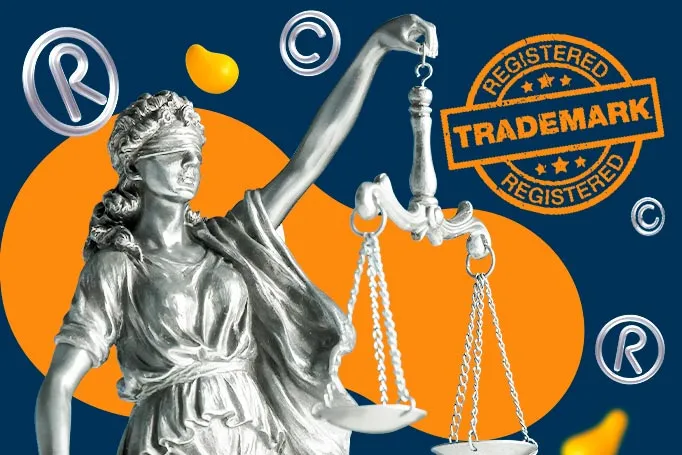Imagine finally opening your small or mid-sized business. You’ve chosen your color palette, your graphic designer added those final touches to your logo design, your copywriter has perfected your slogan, and you’ve finally signed those investors who have been toeing the line.
Everything is in order. You launch your business and fulfill those pre-orders, and the sky is bluer than ever. What could possibly go wrong?
Well, a week into your launch, your friend sends you a screenshot of another company that also just launched. They have the same color palette, a very similar name, and a nearly identical logo. They sell similar products for less money and are riding the coattails of your hard work.
“Did you trademark your business?” Your friend asks.
“I thought only big corporations needed that. I didn’t think I had to.”
People aren’t the only ones who suffer from identity theft and fraud.
Businesses do, too just not in the same way. In this blog, we will explore the world of trademarks and why every company should be protecting their brand with one.
What is a trademark?
A registered trademark distinguishes the source of your products or services. It prevents bad actors from being able to replicate your logo, unique name, symbols, and even certain aspects of your color palette.
Trademarks protect the visual identity of your company so that consumers can identify and distinguish you without giving their business to a copycat company. Trademark registration isn’t just nice to have, especially in the age of social media. It’s a must-have.
Trademark vs Copyright vs Patent
If this is your first time reading in-depth about trademarks, you may not know the difference between trademarks, copyrights, and patents.
Trademark: A trademark protects a word, phrase, design, and logo of your brand and identifies goods and services as being from your company.
Copyright: Copyrights protect an original work of art, literature, or music. Delia Owens has a copyright on Where the Crawdads Sing and Taylor Swift has a copyright on her Folklore album.
United States patent: A patent typically applies to inventions. For example, if you invented a self-lighting candle, then you would apply for a patent that protects the invention itself or anyone else from taking credit for your invention.
<div class="c-blog_comp-custom"><div class="c-blog_comp-custom-wrapper"><div id="w-node-_3e15908c-76d3-04c1-4d51-974fa73db438-e4b52634" class="c-blog_comp-custom-element"><img src="https://global-uploads.webflow.com/61cdf3c5e0b8155f19e0105b/6334e9ec0821775f1e0270cd_TM.png" loading="lazy" alt="" class="c-blog_comp-custom-icon"><div class="c-text-wrapper"><div class="c-blog_comp-custom-text">Used for a trademark that has not yet been registered</div></div></div><div id="w-node-_2a6ff5b3-c537-2fac-1ba3-24b27359c26f-e4b52634" class="c-blog_comp-custom-element"><img src="https://global-uploads.webflow.com/61cdf3c5e0b8155f19e0105b/6334e9ec1512f71c8e6955a3_R.png" loading="lazy" alt="" class="c-blog_comp-custom-icon"><div class="c-text-wrapper"><div class="c-blog_comp-custom-text">Used for a product or service that has been registered and is legally protected</div></div></div><div id="w-node-_223241c6-4b71-4222-5a41-f6307601eadd-e4b52634" class="c-blog_comp-custom-element"><img src="https://global-uploads.webflow.com/61cdf3c5e0b8155f19e0105b/6334e9ecf6bc388207c01049_SM.png" loading="lazy" alt="" class="c-blog_comp-custom-icon"><div class="c-text-wrapper"><div class="c-blog_comp-custom-text">Used for a service mark that has not yet been registered</div></div></div><div id="w-node-_127db5c5-8d76-6632-9ff3-01db7c1dbef1-e4b52634" class="c-blog_comp-custom-element"><img src="https://global-uploads.webflow.com/61cdf3c5e0b8155f19e0105b/6334e9ed239c9e34e1a9927e_C.png" loading="lazy" alt="" class="c-blog_comp-custom-icon"><div class="c-text-wrapper"><div class="c-blog_comp-custom-text">Used to notify the authorship of non-audio works</div></div></div><div id="w-node-_653e1220-65f1-2c54-8a2f-0ba0a447cef5-e4b52634" class="c-blog_comp-custom-element"><img src="https://global-uploads.webflow.com/61cdf3c5e0b8155f19e0105b/6334e9ed5935576b4b604e33_P.png" loading="lazy" alt="" class="c-blog_comp-custom-icon"><div class="c-text-wrapper"><div class="c-blog_comp-custom-text">Used to notify the copyright of audio works</div></div></div></div></div>
Why you should trademark your brand identity
If you’re a small to mid-sized business, it’s easy to assume that trademarking, copyrighting, and patenting are things better left to the big fish. This couldn’t be further from the truth.
Bad actors typically know better than to steal a large company’s brand identity. Especially because large companies generally have a strong brand identity that would be extremely difficult to replicate successfully.
They would rather aim for the smaller targets who have more to lose. Smaller companies are less likely to have patents and trademarks, making it easier for them to steal not only goods and services but your actual brand personality.
<div class="c-blog_comp-cta cc-component-1"><div class="c-blog_comp-cta-left"><div class="c-blog_comp-cta-left-wrap"><img src="https://global-uploads.webflow.com/61cdf3c5e0b8155f19e0105b/6334d81a29c751ccd8c26638_brain-orchestra.png" loading="lazy" alt="" sizes="(max-width: 479px) 93vw, (max-width: 767px) 96vw, 363px" srcset="https://global-uploads.webflow.com/61cdf3c5e0b8155f19e0105b/6334d81a29c751ccd8c26638_brain-orchestra-p-500.png 500w, https://global-uploads.webflow.com/61cdf3c5e0b8155f19e0105b/6334d81a29c751ccd8c26638_brain-orchestra.png 500w" class="c-blog_comp-cta-left-img"></div></div><div class="c-blog_comp-cta-right"><div class="c-blog_comp-content"><div class="c-text-wrapper cc-mb-32"><div class="c-title-4 cc-bold">Ready to engage your audience on a whole new level?</div></div><div class="c-text-wrapper"><div class="c-text-2">Stay ahead of the latest design trends and stand out in your market, no matter how saturated it is.</div></div></div><div class="c-blog_comp-wrapper"><a href="/2022-life-changing-design-trends" class="c-button cc-primary cc-inverted w-button"><strong>Download Latest Design Trends</strong></a></div></div></div>
How to protect your brand
It doesn’t matter what stage in the business journey you are in, if you have a company or brand worth protecting, then you need a trademark. Here are some easy steps to get you started:
A. Understand that your domain name is not a trademark. Although you have the rights to your domain name, which can’t be replicated, it does not protect anything else.
B. Identify your ‘mark’. A mark is what you are protecting or completing the trademark application for. Two things that need to be considered here are:
- Likelihood of confusion (is your mark too similar to another company with a similar product?)
- Strength of your mark (is it unique enough?)- The more unique your mark, the is will be to protect.
C. Clearance-check your mark with the United States Patent and Trademark Office (USPTO). Here is a link to their trademark database.
D. Know your basis for filing
- What is the use and intended use of your trademark, goods, and services?
- Are you selling your product overseas?
- Bona fide intent: What is your current business plan?
E. If you are not US-based, you will need to hire an attorney to represent you. US-based business owners don’t have to do this, but it is strongly recommended. They can guide you through the application procedure.
F. Set up a USPTO account and fill out your application.
Parting advice
The best advice that we can give you, other than trademarking your brand identity, is to hire a qualified attorney. They can help you if your trademark application is denied or if you have questions that can’t be answered by a Google search.
You work hard on your branding strategy, product packaging, and creating a brand identity that people want to buy from. Trademarking your business not only provides a safety net for you if a company tries to ride your coattails but also ensures that your customers always know that they are buying directly from you, their trusted source.
We hope this article will help you understand the importance of trademarking your business. If you have any questions about building a brand identity with a strong brand promise, from your logo down to your business cards, let us offer you a helping hand!
Designity was created for companies just like yours. Get access to an interchangeable team of US-based creatives and a creative director who will act as your creative compass while you navigate the branding waters. Are you ready to start your design journey? Sign up for your two-week trial today!










